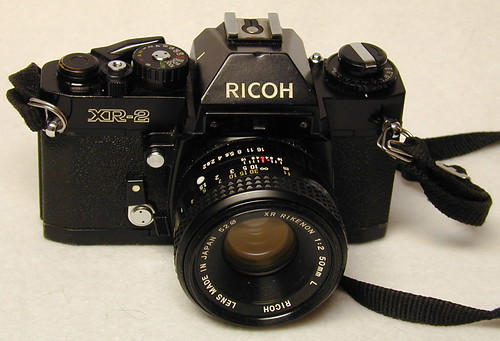Difference between revisions of "Ricoh XR-2"
(add new pool photo of winder-ready XR-2s variant) |
(a couple more feature notes) |
||
| Line 9: | Line 9: | ||
The '''XR-2''' is an [[SLR]] for [[35mm film]] introduced by [[Ricoh]] in 1977. Along with the [[Ricoh XR-1|XR-1]], these were Ricoh's first cameras to accept [[K-mount lens]]es. The XR-2 was a higher-end model offering [[aperture-priority]] autoexposure, with a direct-viewing window showing the lens's aperture setting above the viewfinder image. | The '''XR-2''' is an [[SLR]] for [[35mm film]] introduced by [[Ricoh]] in 1977. Along with the [[Ricoh XR-1|XR-1]], these were Ricoh's first cameras to accept [[K-mount lens]]es. The XR-2 was a higher-end model offering [[aperture-priority]] autoexposure, with a direct-viewing window showing the lens's aperture setting above the viewfinder image. | ||
| − | To unlock the shutter, the film wind lever must be pulled outwards. The electronically-timed [[Copal]] shutter provides a wide range of speeds from 1/1000 second to 4 seconds plus B with [[flash sync]] up to 1/125 sec. The shutter is dependent on power from two 1.5v LR44/SR44 batteries, without which only the mechanical speeds of "X" (1/90th second) and B may be used. A half-press on the shutter release | + | To unlock the shutter and meter indicator, the film wind lever must be pulled outwards; the stowed position avoids accidental battery drain. The electronically-timed [[Copal]] shutter provides a wide range of speeds from 1/1000 second to 4 seconds plus B with [[flash sync]] up to 1/125 sec. The shutter is dependent on power from two 1.5v LR44/SR44 batteries, without which only the mechanical speeds of "X" (1/90th second) and B may be used. |
| + | |||
| + | A half-press on the shutter release activates the exposure indicator needle in the viewfinder. Battery power is checked by twisting a collar around the shutter release. The viewfinder meter needle should swing up to the top of the scale (if good, reaching the notch seen at the side). A rear "ME" switch permits intentional multiple exposures; alongside this is a lever for closing an eyepiece blind. | ||
The 1979 '''Ricoh XR-2s''' is essentially the same camera, but with a baseplate able to accept an optional power winder. | The 1979 '''Ricoh XR-2s''' is essentially the same camera, but with a baseplate able to accept an optional power winder. | ||
| Line 28: | Line 30: | ||
|image= https://live.staticflickr.com/65535/48229249357_99674f50ff_w.jpg | |image= https://live.staticflickr.com/65535/48229249357_99674f50ff_w.jpg | ||
|image_align= left | |image_align= left | ||
| − | |image_text= The XR-2s version,<br>accepting an autowinder | + | |image_text= The XR-2s version,<br>accepting an autowinder<br>(with aftermarket shutter button added) |
|image_by= bokina90 | |image_by= bokina90 | ||
|image_rights= wp | |image_rights= wp | ||
Revision as of 17:00, 10 May 2021

|
| image by Mark O'Brien (Image rights) |
The XR-2 is an SLR for 35mm film introduced by Ricoh in 1977. Along with the XR-1, these were Ricoh's first cameras to accept K-mount lenses. The XR-2 was a higher-end model offering aperture-priority autoexposure, with a direct-viewing window showing the lens's aperture setting above the viewfinder image.
To unlock the shutter and meter indicator, the film wind lever must be pulled outwards; the stowed position avoids accidental battery drain. The electronically-timed Copal shutter provides a wide range of speeds from 1/1000 second to 4 seconds plus B with flash sync up to 1/125 sec. The shutter is dependent on power from two 1.5v LR44/SR44 batteries, without which only the mechanical speeds of "X" (1/90th second) and B may be used.
A half-press on the shutter release activates the exposure indicator needle in the viewfinder. Battery power is checked by twisting a collar around the shutter release. The viewfinder meter needle should swing up to the top of the scale (if good, reaching the notch seen at the side). A rear "ME" switch permits intentional multiple exposures; alongside this is a lever for closing an eyepiece blind.
The 1979 Ricoh XR-2s is essentially the same camera, but with a baseplate able to accept an optional power winder.
Links
- Ricoh XR-2s manual from Mike Butkus' OrphanCameras.com
- Ricoh XR-2 review from November 1979 Popular Photography posted to MFLenses forum by Nesster.
- Rebadged as the Sears KS Auto
- Ricoh advertisement announcing the XR-1 and XR-2 in the
December 1977 Popular Photography; scan courtesy voxphoto.
In Japanese

|
| The XR-2s version, accepting an autowinder (with aftermarket shutter button added) image by bokina90 (Image rights) |